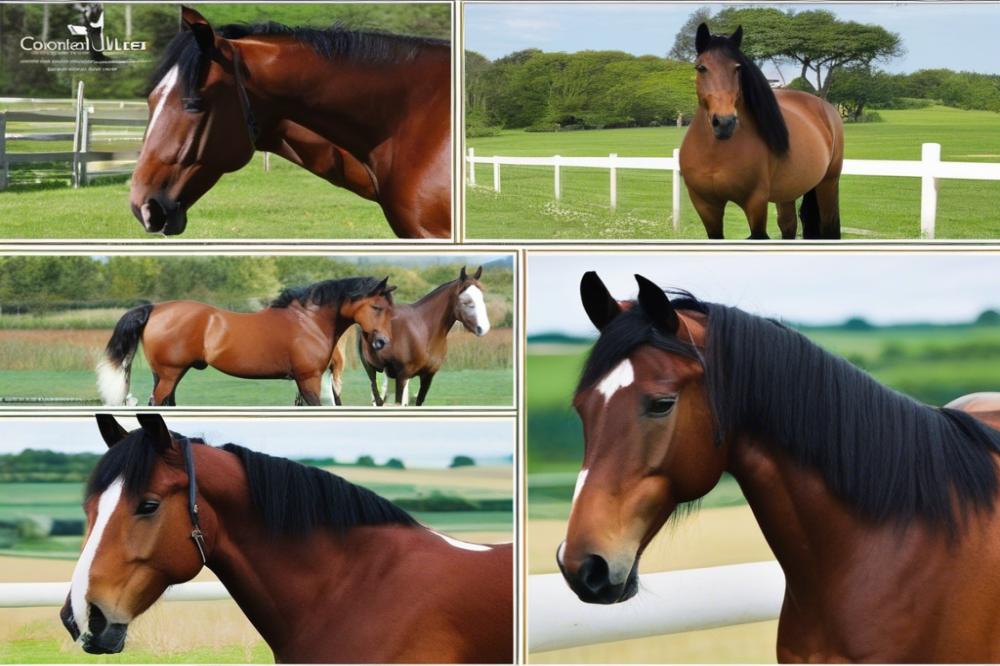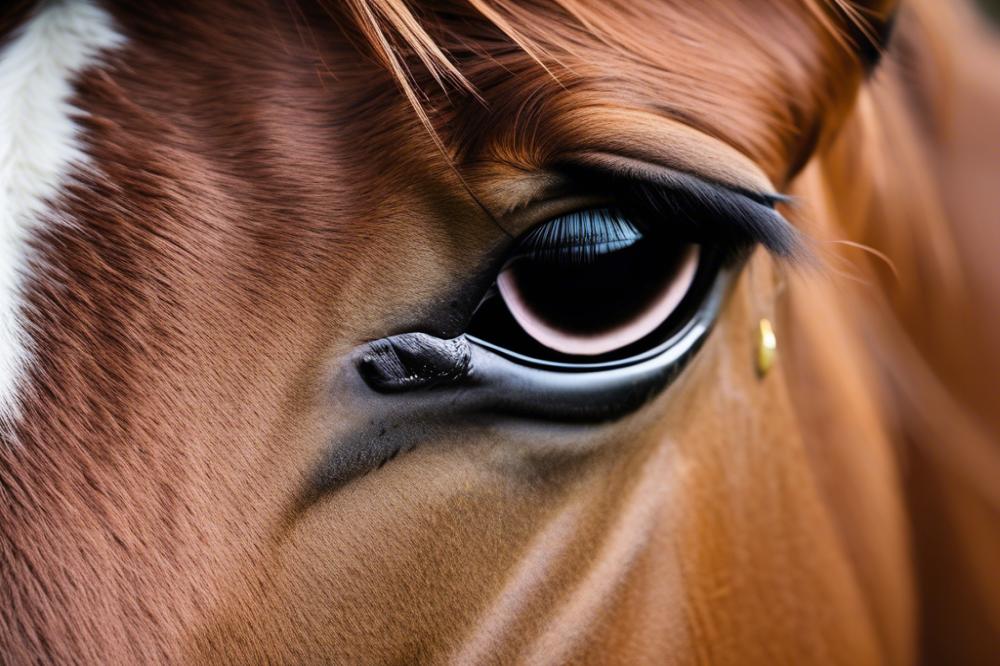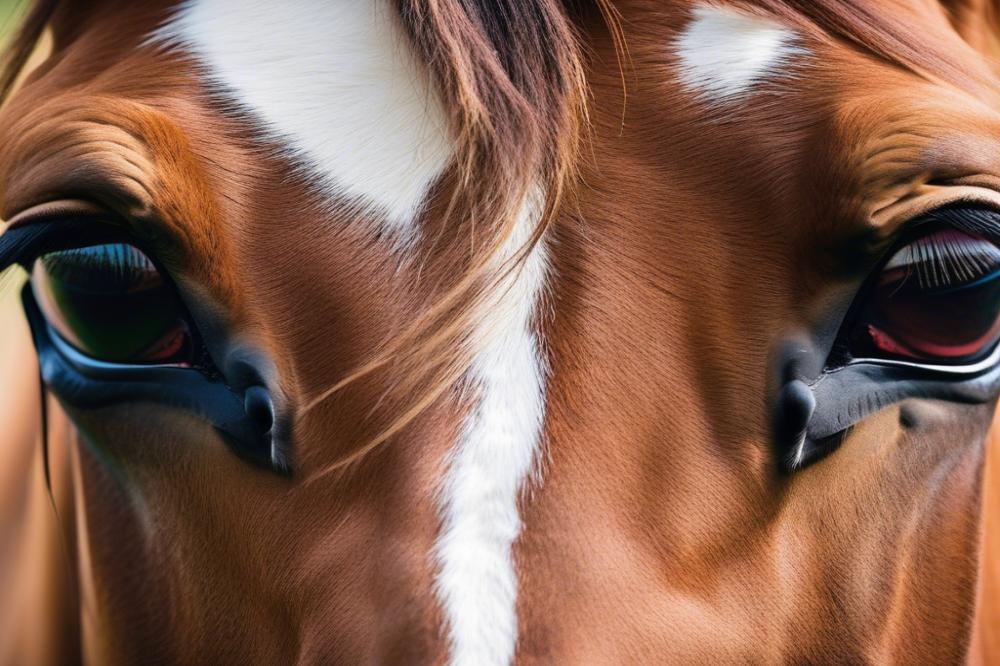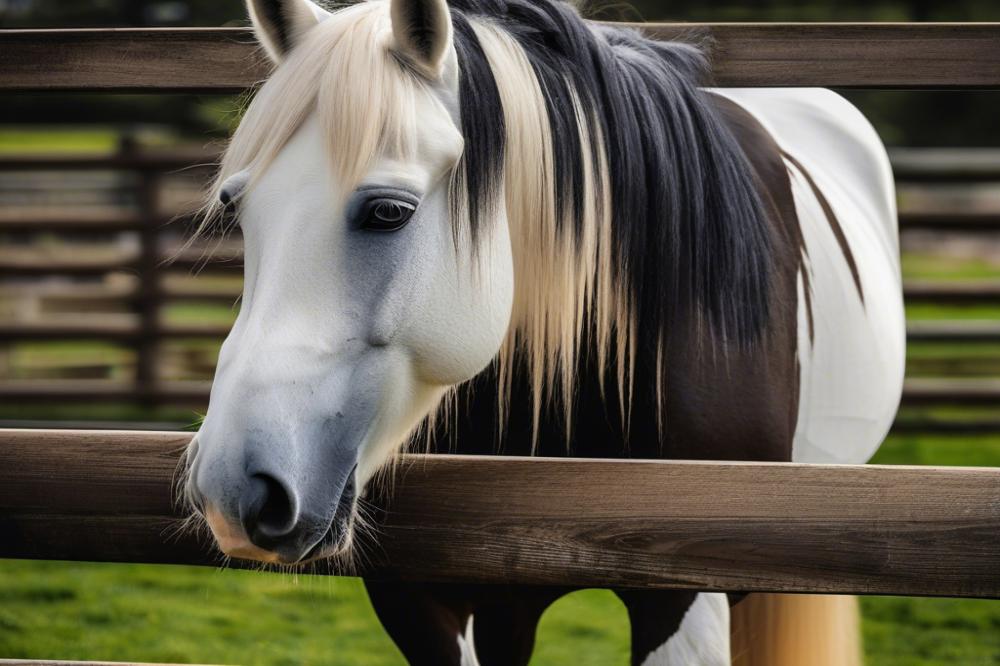Overview of Corneal Ulcers in Horses
When it comes to horse care, a healthy eye is as precious as gold. The eye is a window to a horse’s health and well-being. Unfortunately, horses can develop corneal ulcers, a common yet serious problem that can cause discomfort and even blindness if not treated properly. These ulcers can happen for many reasons, like scratches, foreign objects, or infections. One moment, your horse is happily munching away on some grass, and the next, you’re faced with an unexpected equine issue that needs your attention.
Importance of Prompt Diagnosis and Treatment

Treating eye conditions in horses is no walk in the park, and a corneal ulcer is no exception. Quick action is critical because the longer it goes untreated, the more harm it can do. Imagine having a pesky splinter stuck in your finger; it hurts and can get worse. Just like that, an ulcer can deepen and complicate matters, resulting in a world of hurt for your horse. Remember, your horse communicates through more than just neighing; their eyes give you important clues about their horse health. You wouldn’t want to let just any minor issue slide, thinking it’ll sort itself out. That’s like waiting for a snowstorm to melt in July!
Purpose of the Article

This article aims to shed light on the world of corneal ulcers. By understanding what they are, how they develop, and the best ways to treat them, you’ll be equipped to tackle any eye-related challenges your horse may face. Our goal is to empower horse owners with the knowledge to maintain their horse’s eye care. So, whether you’re branding a horse or simply soaking up some sunshine with your favorite steed, this piece will provide valuable insights. Keep an eye on your horse’s health; it’s worth it! After all, a happy horse means a happy owner, and let’s face it, every horse has its own unique way of letting you know how they feel—just watch those ears. The way they flap and twist can tell you a lot; consider the quirky communication that we sometimes call “horse ear emotion.”
Understanding Corneal Ulcers

Definition and Causes of Corneal Ulcers in Horses
A corneal ulcer is like a sore on the horse’s eye. It happens when there’s damage to the cornea, which is the clear front part of the eye. Think of the cornea as the windshield of a car. If something hits it or scratches it, problems arise. Various factors can lead to this condition. Common culprits include injury, infection, and even foreign bodies like dust or grass. Sometimes, conditions like dry eye can contribute to the issue.
Signs and Symptoms to Look For
When a horse has a corneal ulcer, it may show a few tell-tale signs. Watery eyes are often the first clue. You might notice your horse squinting a lot. An unusual amount of tearing can occur, making those big eyes look even wetter than before. If you see any cloudiness or haze over the eye, that’s a red flag. Watching for changes in how the horse behaves can also help. Many animals will rub their eyes with their hooves or against objects in an attempt to relieve discomfort.
Risk Factors and Predisposing Conditions
Certain horses face higher risks of developing these eye issues. For instance, those with a history of eye problems might be more prone. Horses that spend time in sandy or dusty environments can also have more corneal ulcers. Poor nutrition plays a role too, contributing to weakened overall equine health. Big, boisterous horses may accidentally hurt each other while playing, leading to eye hazards.
Maintaining proper eye care is essential. Keep a watchful eye on your horse, literally! Regular check-ups can sometimes spot problems before they escalate. When your horse gets a little too curious and pokes around, keep an eye out. Eye conditions might sneak up on you, so vigilance is key in horse care and health.
Always remember, prevention is better than cure. A little caution can save you lots of trouble later on!
Diagnosis of Corneal Ulcers
Veterinary Examination Procedures
When a horse shows signs of discomfort in its eyes, a visit to the vet is in order. The rider or owner may notice squinting, tearing, or even swelling around the eye. A vet will first perform a thorough examination of the horse’s eye and surrounding areas. They’ll look for redness or discharge, and observe how the horse reacts when light shines into its eyes. Sometimes, checking the horse’s overall health provides clues as well. Remember, equine health concerns can be tricky, so no detail is too small to mention.
Diagnostic Tests and Imaging
After a good look, vets often resort to some nifty diagnostic tests. One common test involves staining the eye with a special dye. This dye highlights any damage to the surface. If there’s an ulcer, the dye will cling to it, giving a clear picture of the problem. For deeper issues, imaging techniques like ultrasound might be used. This helps visualize structures behind the eye. Each test plays a vital role in diagnosing what’s wrong.
Differential Diagnoses
Several equine issues can mimic corneal ulcers. Inflammation, foreign bodies, or infections might be culprits that look similar. Vets need to be detectives in such cases. They’ll rule out other problems by examining symptoms closely. It’s easy to misdiagnose when you only know a little. For example, uveitis can appear like an ulcer. This confusion highlights why proper eye care is essential. Knowledge is power when managing a horse’s health.
There’s always a chance that what seems like a simple problem isn’t. The brave horse might be hiding its pain well. Vets use experience and intuition, along with tests, to navigate these tricky waters. With attentive care, many horses recover fully. It’s a good day when everything comes together for a horse’s health.
Treatment Options
Medical Management and Medications
When a horse develops a corneal ulcer, the first step is often medical treatment. Vets typically prescribe topical antibiotics to fight infection. These special medications work like knights in shining armor, bravely defending the eye from harmful bacteria. Pain relief is also crucial. Your horse can’t tell you they hurt, so managing discomfort is key to their recovery. Sometimes, anti-inflammatory drugs are included to help with swelling.
In addition, some horses might need a special ointment that promotes healing. These eye drops help keep the surface moist. Keeping the eye hydrated is similar to watering a plant; without it, healing dries up. It’s vital to follow the vet’s instructions closely. Never skip a dose or decide to stop treatment early. This can lead to complications, much like throwing away a puzzle piece before finishing the picture.
Surgical Interventions When Necessary
Surgery may sound scary, but sometimes it’s just what a horse needs. Certain ulcers cannot heal through medication alone. In these cases, your vet might recommend a procedure to repair the damage. A procedure called a conjunctival flap is one option. This involves moving tissue from the eyelid to cover the ulcer. It’s like creating a blanket for the eye to help it heal better.
Laser therapy is another tool in the vet’s toolbox. This high-tech approach can help stimulate healing. Some veterinarians even use cryotherapy, which literally freezes tissue to help tackle deeper issues. Owners might feel anxious about surgery, but it’s often necessary for a full recovery. Remember, poor equine health today can lead to bigger issues tomorrow.
Follow-Up Care and Monitoring
Caring for a horse with an eye issue doesn’t end when treatment starts. Regular check-ups with the vet are essential. These visits help ensure the ulcer is healing properly. Your vet may perform tests to check for any signs of infection. Each follow-up is like a pit stop in a race; it’s vital for keeping the horse on track.
Keep an eye on your horse at home too. Watch for changes in behavior or signs of discomfort. If your horse resists having its head touched or seems unusually sensitive to light, that could indicate trouble. Changes in appetite can also be a red flag. Horse care doesn’t end with the vet’s visit; it’s a continuous process.
Lastly, the environment plays a crucial role in recovery. Keeping the horse in a clean and quiet space can aid healing. Provide fresh water and easy access to food. Like a cozy nest for a bird, a comfortable environment helps your horse recover quicker. Monitoring their progress is equally important. Be proactive and attentive; the better the follow-up, the lower the risk of equine issues surfacing later.
Prevention Strategies
Best Practices for Horse Care and Management
Taking care of a horse is much like caring for a family member. It’s important to stay vigilant about their daily needs. Keep the stall clean and free from debris. A tidy environment helps reduce unnecessary injuries. Regularly check the horse’s eyes for any signs of irritation. Noticing small changes can prevent bigger problems later on. Nutrition plays a key role in maintaining equine health. A well-balanced diet keeps your horse shining like a star. As they say, you can’t paint a masterpiece without the right colors.
Environmental Considerations
Horses love to roam, but their surroundings can become problematic. Sandy, dusty, or muddied areas can lead to injuries, especially around the eyes. Always provide shelter from harsh weather conditions. Sun can be just as damaging as rain. Make sure paddocks are properly drained to avoid standing water. Wet conditions invite all sorts of pests. Keeping the area tidy also discourages flies and other annoyances. After all, we wouldn’t want a bunch of uninvited guests bothering our friends, would we?
Regular Veterinary Check-Ups
Imagine your horse as a star athlete needing regular check-ups. Routine veterinary visits are crucial for eye care and overall health. A veterinarian can spot early signs of equine issues before they turn serious. Annual vaccinations and dental care are essential, too. Discuss any eye concerns during these visits. Your vet can offer tailored advice to keep those peepers in perfect shape. Always remember, a stitch in time saves nine. Keeping up with veterinary schedules within the context of horse health is just smart thinking!
Prognosis and Outcomes
The prognosis for horses with corneal ulcers varies a great deal. Many horses can recover completely, given the right treatment and care. Some ulcers are mild, while others might be more serious and take longer to heal. The key lies in early intervention and the type of ulcer. If treated promptly, a horse might return to its usual self in no time. However, some may face challenges along the way.
Factors Influencing Recovery
Several factors play a big role in recovery. Firstly, the horse’s overall health is crucial. A sturdy horse with no underlying health issues often has a better chance of healing well. Age can also be a factor. Young horses often bounce back quickly, while older ones might need extra time. The type of ulcer affects recovery too. Superficial ulcers usually heal faster than deeper ones. Remember, how well a horse responds depends heavily on prompt and appropriate medical attention.
Potential Complications and How to Manage Them
Complications can arise during the healing process. These may include persistent inflammation or even infection. Owners should watch for any signs of worsening. If a horse is squinting or showing increased discharge from the eye, it might indicate trouble. Regular vet check-ups are essential. Having a vet look at the eye ensures that nothing serious is developing. In some cases, additional medications like antibiotics or anti-inflammatory drugs can help. Don’t hesitate to ask questions. It’s okay to be a little anxious when it comes to eye care. After all, our horses depend on us!
Long-term Effects
Long-term effects of corneal ulcers can vary. Some horses may experience changes in their vision, while others might have no issues at all. Scarring on the cornea can occur, impacting the horse’s vision slightly. Owners need to keep an eye on their horses after recovery. Frequent observations can help notice any changes in behavior or sight. In the world of equine health, prevention always takes the spotlight. Using protective gear and maintaining a clean stable environment can reduce the chances of future eye issues. It’s better to be proactive; an ounce of prevention is worth a pound of cure!
Owner Responsibilities and Awareness
Importance of Owner Education
In the world of horse care, knowledge is power. Understanding equine health, especially when it comes to eye care, can help prevent serious issues. If owners lack information about corneal ulcers, they may overlook early warning signs. The more you know, the better decisions you can make for your horse’s well-being. Joining workshops or reading materials on equine issues can be enlightening. Horse owners should always stay curious and ask questions. Being well-informed can mean the difference between a minor treatment and a major problem.
Recognizing Early Signs and Acting Quickly
Ever notice your horse is squinting more than usual? That could be an early indicator that something’s not right. Other signs to look for include excessive tearing or even a change in personality—maybe your normally friendly horse seems a bit cranky. Quick action is crucial. It’s like that old saying: “A stitch in time saves nine.” Early intervention can be vital for eye health. If you suspect a problem, don’t delay. Reach out to your vet and describe your observations.
Building a Relationship with Your Veterinarian
Good relationships don’t just happen. They take time and communication. Building a bond with your veterinarian helps ensure your horse receives the best care. A vet who understands your horse’s history will be more effective in diagnosing any potential equine health issues. Share your concerns and be open about any changes you notice. This kind of dialogue can lead to better care. You know your horse best. Trust your instincts and keep your vet in the loop.
Wrapping It Up
As we draw our discussion to a close, it’s important to highlight the essential points regarding caring for your horse’s eyes. Corneal ulcers can lead to serious issues, and recognizing the signs early is key. Keep a lookout for any squinting, tearing, or a cloudy appearance in your horse’s eye. Just like humans might complain about a headache, horses can show discomfort in their own ways, even if they can’t quite tell us what’s wrong.
Proactive care truly makes all the difference. Regular check-ups with a veterinarian are vital for eye health. A horse owner who dabbles in a bit of routine eye examination can really catch potential problems before they get out of hand. Find time to learn about your horse’s unique behaviors—think of it as picking up on the donkey temperament that tells you when something’s off. This could turn into a fun bonding experience, and “horse girl stereotypes” aside, it’s a great way to get to know your equine friend better.
While the thought of eye problems can be daunting, your positive approach can create an environment where your horse thrives. Minor issues can often be treated successfully if caught early, so don’t hesitate to seek veterinary advice at the first sign of trouble. As with many things in life, a stitch in time saves nine, and staying informed is part of being a responsible horse owner.
In essence, eye health is a significant piece of maintaining overall well-being for your horse. From the moment you adopt your furry companion, developing a routine that includes eye care will help keep them galloping happily into the future. Here’s to many more adventures, clear days, and healthy eyes!



